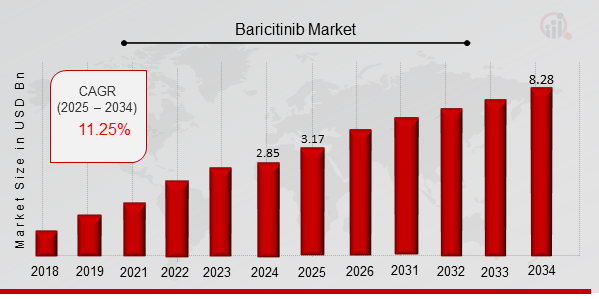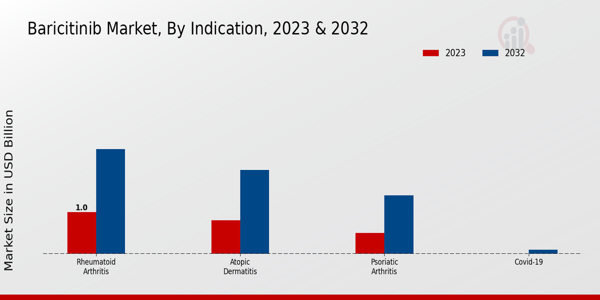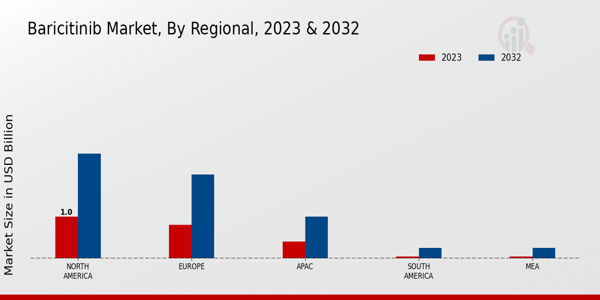Baricitinib Market Overview
As per MRFR analysis, the Baricitinib Market Size was estimated at 2.85 (USD Billion) in 2024. The Baricitinib Market Industry is expected to grow from 3.17 (USD Billion) in 2025 to 8.28 (USD Billion) till 2034, at a CAGR (growth rate) is expected to be around 11.25% during the forecast period (2025 - 2034).
Key Baricitinib Market Trends Highlighted
The Global Baricitinib Market is experiencing significant growth driven primarily by the increasing incidence of autoimmune diseases and the rising demand for effective therapeutic options. Healthcare providers and patients alike are seeking innovative treatments that can improve the quality of life for those suffering from conditions like rheumatoid arthritis. Additionally, the ongoing research and development efforts in the biopharmaceutical industry are enhancing the market potential for baricitinib. The increasing approval and adoption of this drug for various indications are also acting as key market drivers, leading to heightened awareness and interest among both clinicians and patients.
There are several opportunities to be explored in the Global Baricitinib Market, particularly in emerging economies where access to effective autoimmune therapies is limited. Pharmaceutical companies can focus on expanding their presence in these regions and tailoring their marketing strategies to local needs. Investment in awareness programs about the benefits of baricitinib for various conditions can enhance market penetration. Partnerships and collaborations between drug developers and healthcare providers can lead to more comprehensive treatment solutions, making it easier for patients to access the medication. Trends in recent times indicate a growing interest in personalized medicine, where treatments like baricitinib can be customized to fit individual patient profiles.
Additionally, the integration of digital health technologies is enhancing patient engagement, enabling better adherence to treatment plans. The focus on real-world evidence and outcomes is also reshaping the market landscape. As more data becomes available regarding the effectiveness and safety of baricitinib, the demand for this medication is likely to rise, further impacting its position in the global pharmaceutical market.

Source: Primary Research, Secondary Research, MRFR Database and Analyst Review
Baricitinib Market Drivers
Growing Prevalence of Chronic Diseases
The Global Baricitinib Market Industry is experiencing significant growth driven by the increasing prevalence of chronic diseases such as rheumatoid arthritis, alopecia areata, and atopic dermatitis. These conditions have become widespread across various demographics, resulting in a growing need for effective therapeutic options. Baricitinib, as a JAK inhibitor, has demonstrated its efficacy in managing these ailments, offering patients a viable solution that can significantly improve their quality of life.
Furthermore, the rise in patient awareness about treatment options and the overall development of healthcare infrastructure has led to a higher diagnosis rate and treatment-seeking behavior among patients. The increasing burden of these chronic diseases necessitates innovative treatments, thus fueling the Global Baricitinib Market Industry. Additionally, there is a growing emphasis on personalized medicine, which aims to tailor treatments to individual patient profiles.
Baricitinib's ability to be effective for varying populations and its relatively manageable safety profile add to its appeal as a critical therapeutic option in the global healthcare landscape. As patients and healthcare providers recognize the need for more efficient treatments, the demand for drugs like Baricitinib is expected to rise, propelling the industry's growth further in the upcoming years. As the healthcare sector continues to adapt to the rising burden of chronic diseases, the Global Baricitinib Market Industry will likely play a pivotal role in providing effective therapeutic solutions that cater to the evolving needs of patients.
Advancements in Biotechnology
The Global Baricitinib Market Industry is substantially driven by advancements in biotechnology that have facilitated the development and production of innovative medications. The introduction of biological therapies has revolutionized the treatment landscape for autoimmune diseases, and Baricitinib stands out as a key player in this category. As research and development capabilities improve, the efficiency in producing high-quality therapeutic agents like Baricitinib has increased.The integration of new technologies in the formulation process ensures better drug stability and targeted delivery, enhancing the overall treatment experience for patients. This continuous evolution in biotechnology not only streamlines the development process but also encourages investment in research, subsequently boosting the Global Baricitinib Market Industry.
Rising Healthcare Expenditure
Rising healthcare expenditure across various nations is another significant driver for the Global Baricitinib Market Industry. As countries increasingly allocate resources to improve their healthcare systems, there is a heightened focus on investing in advanced treatment options for chronic diseases. Patients are becoming more willing to spend on effective therapies, driving demand for medications like Baricitinib. This trend is particularly evident in developed countries where healthcare budgets have expanded, enabling better access to innovative treatments.Consequently, this rise in healthcare expenditure not only reflects positively on the Global Baricitinib Market Industry but also contributes to improved patient outcomes as new therapies become more widely accessible.
Baricitinib Market Segment Insights:
Baricitinib Market Indication Insights
The Global Baricitinib Market, particularly focusing on the Indication segment, showcases significant growth and variations across its different applications. As of 2023, the overall market is valued at 2.3 USD Billion, and this figure reflects the rising demand for effective treatments amidst increasing incidences of various inflammatory conditions. The market is largely driven by the significant prevalence of Rheumatoid Arthritis, which alone accounted for a valuation of 1.0 USD Billion in 2023 and is projected to rise to 2.5 USD Billion by 2032. This sub-segment holds a majority share in the Global Baricitinib Market revenue, making it a key area for research and development efforts due to its widespread impact on patients' quality of life. Atopic Dermatitis, with a valuation of 0.8 USD Billion in 2023, stands as another important sub-segment, expected to reach 2.0 USD Billion by 2032. The increasing incidence of this chronic skin condition, particularly among younger populations, is anticipated to fuel market growth, presenting a significant opportunity for new therapeutic solutions in a field with substantial unmet needs. Similarly, Psoriatic Arthritis, initially valued at 0.5 USD Billion in 2023, is projected to grow to 1.4 USD Billion by 2032. This reflects an increasing recognition of the disease’s burden, which often leads to both physical and psychological challenges for patients, highlighting the need for effective management options.COVID-19's influence on the Global Baricitinib Market is notable, with a valuation of 0.0 USD Billion in 2023, expected to marginally grow to 0.1 USD Billion by 2032. This segment’s relatively minor share indicates that while Baricitinib has been explored for its potential role in treating COVID-19, its primary applications lie in treating chronic inflammatory disorders. The overall growth of the Global Baricitinib Market is supported by ongoing advancements in treatment protocols and a deeper understanding of chronic diseases. Market trends suggest an increasing investment in research initiatives aimed at expanding the drug's application spectrum. With continuous innovations, the Global Baricitinib Market segmentation for indications is poised to transform healthcare approaches for these conditions, contributing to broader therapeutic options and improving patient outcomes.

Source: Primary Research, Secondary Research, MRFR Database and Analyst Review
Baricitinib Market Route of Administration Insights
The Global Baricitinib Market is expected to be valued at 2.3 USD billion in 2023, with various segments contributing to its growth, particularly focusing on the Route of Administration. This market segmentation is crucial as it highlights different methods through which the drug can be administered, significantly impacting patient compliance, therapeutic efficacy, and overall market growth. The oral administration route has grown in importance due to its convenience and higher patient acceptance, making it a significant player in the market. Intravenous administration, while less commonly used, plays a critical role in hospital settings for rapid drug delivery, often being preferred for acute cases.The aim to improve patient outcomes drives ongoing innovations across these routes, enhancing formulations and delivery mechanisms. Overall, market dynamics reveal a strong preference for oral administration, reflecting a shift towards less invasive treatments. Insights from market data indicate that growth drivers, such as increasing incidences of rheumatoid arthritis and evolving healthcare practices, are pivotal, while factors like regulatory challenges may present hurdles. Market statistics also reveal that a diverse range of administration methods paves new opportunities to expand the therapeutic landscape for Baricitinib.
Baricitinib Market End User Insights
In 2023, the Global Baricitinib Market was valued at approximately 2.3 billion USD, highlighting the growing demand across various end users such as hospitals, clinics, and homecare settings. Hospitals are crucial in the distribution and administration of Baricitinib, catering to a large patient base with complex medical needs. Clinics play a significant role in providing accessible treatment options, allowing for more patients to receive timely care. Meanwhile, the homecare segment is becoming increasingly important as more individuals prefer receiving treatments in the comfort of their homes, promoting adherence and convenience.
The combination of these end users contributes to the overall market growth, driven by factors such as the rising incidence of conditions treated with Baricitinib, the increase in healthcare expenditures, and growing awareness about effective treatment options. However, challenges such as pricing pressures and regulatory hurdles may impact market dynamics. As the market expands, opportunities arise for innovation in delivery methods and patient engagement strategies, further enhancing the Global Baricitinib Market revenue. Market dynamics also indicate that the segmentation between these end users will continue to evolve, reflecting changing patient preferences and healthcare trends.
Baricitinib Market Distribution Channel Insights
The Global Baricitinib Market revenue is expected to reach 2.3 USD Billion in 2023, demonstrating robust growth in the Distribution Channel segment. This market is experiencing a shift with significant contributions from Retail Pharmacies, Hospital Pharmacies, and Online Pharmacies. Retail Pharmacies continue to play a crucial role due to their accessibility and customer engagement, often being the first point of contact for patients seeking Baricitinib. Hospital Pharmacies dominate this segment as they provide immediate access to crucial therapies for inpatients and outpatient procedures, often driven by the rising prevalence of chronic diseases where Baricitinib is prescribed.
Meanwhile, Online Pharmacies are gaining momentum, reflecting the trend towards digital health solutions and increased consumer preference for convenient purchasing options. These distribution channels are essential in ensuring the availability and efficient delivery of Baricitinib products, aligning with the growing demand and changing patient behaviors in the Global Baricitinib Market industry. As the market evolves, these channels are expected to adapt to enhance their service offerings and meet the dynamic needs of healthcare consumers, illustrating the importance of a diverse Distribution Channel strategy within the Global Baricitinib Market segmentation.
Baricitinib Market Regional Insights
The Global Baricitinib Market is experiencing substantial growth across various regions, with a total valuation of 2.3 USD Billion in 2023 and a predicted increase to 6.0 USD Billion by 2032. North America holds a majority share, valued at 1.0 USD Billion in 2023 and expected to reach 2.5 USD Billion by 2032, driven by robust healthcare infrastructure and a growing prevalence of autoimmune diseases. Europe follows closely, valued at 0.8 USD Billion in 2023 and projected to grow to 2.0 USD Billion, reflecting strong support for innovative healthcare solutions.
The APAC region is emerging, with a valuation of 0.4 USD Billion in 2023 and a forecast of 1.0 USD Billion by 2032, showcasing rising demand due to increasing awareness and accessibility to treatment options. South America and MEA each hold a valuation of 0.05 USD Billion in 2023, with expectations to grow to 0.25 USD Billion by 2032, indicating a developing market that presents opportunities for growth and expansion. Overall, the Global Baricitinib Market segmentation highlights promising opportunities driven by regional healthcare advancements and the need for effective treatment options.

Source: Primary Research, Secondary Research, MRFR Database and Analyst Review
Baricitinib Market Key Players and Competitive Insights:
The Global Baricitinib Market is characterized by a rapidly evolving landscape driven by the increasing prevalence of autoimmune disorders and the expanding indications for the drug. Baricitinib, as a selective Janus kinase (JAK) inhibitor, has gained significant traction among healthcare professionals and patients alike, particularly in the management of conditions such as rheumatoid arthritis and alopecia areata. The competitive dynamics of this market are influenced by various factors, including the entry of new players, ongoing clinical trials, and strategic partnerships aimed at gaining market share. Companies are focusing on innovation and patient-centric solutions to differentiate their offerings while also navigating the complexities of regulatory approvals and market access to position themselves favorably in this competitive environment.
Johnson and Johnson has established a substantial presence in the Global Baricitinib Market, leveraging its extensive experience in the pharmaceutical sector and a robust pipeline of products. The company's strength lies in its strong research and development capabilities, enabling it to innovate and optimize formulations that enhance therapeutic outcomes. Johnson and Johnson's established reputation and brand recognition provide a competitive advantage, fostering trust among healthcare providers and patients. Furthermore, the company’s effective marketing strategies and comprehensive distribution networks ensure the widespread availability of its products, thereby reinforcing its position in the marketplace. Their commitment to addressing unmet medical needs through ongoing investment in clinical research strengthens their foothold in this competitive arena.Takeda Pharmaceutical Company also plays a significant role in the Global Baricitinib Market, marked by its dedication to developing treatments for complex and debilitating diseases. The company boasts a global reach that allows it to tap into diverse markets, enhancing the accessibility of its baricitinib offerings. Takeda's strengths are complemented by its focus on patient-centric care and commitment to safety and efficacy in its drug development processes. The integration of patient feedback into their development strategies fosters a responsive approach to market demands. Moreover, Takeda's strategic alliances and collaborations with various stakeholders in the healthcare ecosystem assist in broadening its market presence and drive innovation, positioning the company as a formidable player within the baricitinib therapeutic landscape.
Key Companies in the Baricitinib Market Include:
Baricitinib Market Industry Developments
The Global Baricitinib Market has recently witnessed significant developments, particularly in the realm of new indications for the drug. Companies like Johnson and Johnson and Eli Lilly and Company have been focusing on expanding their portfolios and indications for Baricitinib, especially in treating conditions like rheumatoid arthritis and alopecia areata. Takeda Pharmaceutical Company continues to enhance its product offerings, while Gilead Sciences is exploring potential combinations with other therapeutics to improve efficacy. Meanwhile, there have been notable mergers and acquisitions in the sector; Bristol Myers Squibb has been actively pursuing partnerships that complement its existing therapies, driving competitive dynamics in the market. The financial landscape for companies such as Roche, Novartis, and Merck & Co has also seen marked growth, with stock prices reflecting strong investor confidence attributed to robust pipeline developments. This uptick is influencing market valuations positively, pushing the Global Baricitinib Market toward a broader acceptance among healthcare providers and patients alike. AstraZeneca and AbbVie Inc. are also involved in expanding research collaborations that promise to enhance innovative treatment approaches, confirming the ongoing strategic realignments across the sector.
Baricitinib Market Segmentation Insights
-
Baricitinib Market Indication Outlook
-
Rheumatoid Arthritis
-
Atopic Dermatitis
-
Psoriatic Arthritis
-
COVID-19
-
Baricitinib Market Route of Administration Outlook
-
Oral
-
Intravenous
-
Baricitinib Market End User Outlook
-
Hospitals
-
Clinics
-
Homecare
-
Baricitinib Market Distribution Channel Outlook
-
Retail Pharmacies
-
Hospital Pharmacies
-
Online Pharmacies
-
Baricitinib Market Regional Outlook
-
North America
-
Europe
-
South America
-
Asia Pacific
-
Middle East and Africa
| Report Attribute/Metric |
Details |
|
Market Size 2024
|
2.85 (USD Billion)
|
|
Market Size 2025
|
3.17 (USD Billion)
|
|
Market Size 2034
|
8.28 (USD Billion)
|
|
Compound Annual Growth Rate (CAGR)
|
11.25 % (2025 - 2034)
|
|
Report Coverage
|
Revenue Forecast, Competitive Landscape, Growth Factors, and Trends
|
|
Base Year
|
2024
|
|
Market Forecast Period
|
2025 - 2034
|
|
Historical Data
|
2020 - 2024
|
| Market Forecast Units |
USD Billion |
| Key Companies Profiled |
Johnson and Johnson, Takeda Pharmaceutical Company, Teva Pharmaceutical Industries, Gilead Sciences, Incyte Corporation, Bristol Myers Squibb, Roche, Novartis, Pfizer Inc, Amgen Inc, Eli Lilly and Company, AbbVie Inc, Merck and Co, Sanofi, AstraZeneca |
| Segments Covered |
Indication, Route of Administration, End User, Distribution Channel, Regional |
| Key Market Opportunities |
Increasing rheumatoid arthritis prevalence, Expansion into oncology applications, Growing demand for advanced therapies, Rising autoimmune disease incidence, Strategic collaborations and partnerships |
| Key Market Dynamics |
Rising prevalence of rheumatoid arthritis, Increasing adoption of targeted therapies, Growing investment in bio-pharmaceuticals, Expanding patient population, Regulatory approvals and reimbursement policies |
| Countries Covered |
North America, Europe, APAC, South America, MEA |
Frequently Asked Questions (FAQ) :
The Global Baricitinib Market is expected to be valued at 8.28 USD Billion by 2034.
The expected CAGR for the Global Baricitinib Market is 11.25% from 2025 to 2034.
North America is projected to have the largest market share, valued at 2.5 USD Billion by 2032.
The market size for Atopic Dermatitis indication is expected to reach 2.0 USD Billion by 2032.
Key players in the market include Johnson and Johnson, Takeda Pharmaceutical Company, and Pfizer Inc.
The market for Rheumatoid Arthritis is expected to be valued at 2.5 USD Billion by 2032.
The market size for Psoriatic Arthritis indication is projected to reach 1.4 USD Billion by 2032.
The market size for the Asia-Pacific region is expected to be 1.0 USD Billion by 2032.
The expected market size for South America is projected to reach 0.25 USD Billion by 2032.
The Global Baricitinib Market is expected to be valued at 2.3 USD Billion in 2023.

















